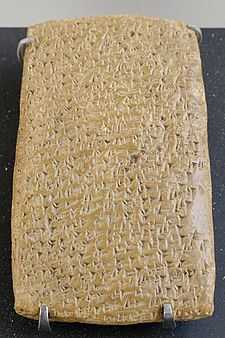Bad (cuneiform)


(Walters 42699; see clay impression below)
signs read down from top: column left (line no. 1), 3rd sign is the bad sign.
Note line no. 1 appears as "line 3", until printed in the clay, and then appearing as "line no. 1".
The cuneiform bad, bat, be, etc. sign is a common multi-use sign in the mid 14th-century BC Amarna letters, and the Epic of Gilgamesh. In the Epic it also has 5 sumerogram uses (capital letter (majuscule)). From Giorgio Buccellati (Buccellati 1979) 'comparative graphemic analysis' (about 360 cuneiform signs, nos. 1 through no. 598E), of 5 categories of letters, the usage numbers of the bad sign are as follows: Old Babylonian Royal letters (71), OB non-Royal letters (392), Mari letters (2108), Amarna letters (334), Ugarit letters (39).[1]
The following linguistic elements are used for the bad sign in the 12 chapter (Tablets I-Tablet XII) Epic of Gilgamesh:[2]
- bad (not in Epic)
- bat
- be
- mid
- mit
- sun
- til
- ziz
sumerograms:
- BE
- IDIM
- TIL
- ÚŠ
- ZIZ
The following usage numbers for the linguistic elements of sign bad in the Epic are as follows: bad, (0 times), bat, (61), be, (16), mid, (7), mit, (8), sun, (1), til, (11), ziz, (8), BE, (2), IDIM, (2), TIL, (1), ÚŠ, (2), ZIZ, (1).[3]
Instead of a large horizontal, as seen in the (digitized form, but one type of "bad")
![]() , the sign is seen in the Amarna letters as composed of two opposite facing (triangles), the wedges. It can be seen here , Amarna letter EA 153-(lines 153:4, 11), for "King-Lord-mine", "LUGAL, Be-li-ia", where "bēlu" is Akkadian for "lord".[4]
, the sign is seen in the Amarna letters as composed of two opposite facing (triangles), the wedges. It can be seen here , Amarna letter EA 153-(lines 153:4, 11), for "King-Lord-mine", "LUGAL, Be-li-ia", where "bēlu" is Akkadian for "lord".[4]
Literature examples
Amarna letters
The vassal city-state letters to the Pharaoh often reference the King (Pharaoh), as: "King, Lord-mine", where king is represented by LUGAL (king Sumerogram), for Akkadian language šarru-(sometimes LUGAL-ri, represented as "ŠÁR-ri", for king, ŠÁR=LUGAL). For the reverse of EA 362, Rib-Hadda to Pharaoh (plus lines 66-69 on clay tablet side), cuneiform sign be is used for "lord", Akkadian "bēlu".[6] In EA 362, be is only used for the spelling of "lord".
The entire topic of EA 362 is developed on the reverse side, (starting halfway on obverse). The listing of be uses, 10-times, on the reverse (and side lines of 66-69), are as follows:[7]
For "King, Lord-mine" (and partials):
- (line 32)--LUGAL
- (39)--LUGAL be-li-ia
- (40)--be-li
- (42)--be-li
- (46)--LUGAL
- (48)--LUGAL be-li
line 51
line 51
- "And..Lord know, ..now ("now at this time")..."
- "And..Lord know, ..[that] "now at this time"..." (a segue to the letter's ending!)
- (53)--be-li-ia
- (60)--LUGAL be-li-ia
- (64)--LUGAL be-li-ia
- (65)--LUGAL
- (66)--LUGAL be-li
- (68)--LUGAL be-li-ia
Besides be in EA 362, bat is used on the letter's obverse (two adjacent lines).
External links
- Use of be, for Akkadian "Lord", specifically "King, Lord-mine"., (Amarna letter EA 153, lines 153:4, 11)
References
| Wikimedia Commons has media related to Bad (cuneiform). |
| Wikimedia Commons has media related to Cuneiform signs, Amarna letters. |
- ↑ Buccellati, Giorgio, (Ugarit-Forschungen 11, 1979). Comparative Graphemic Analysis of Old Babylonian and Western Akkadian, pp. 95-100, Graph, p. 96.
- ↑ Parpola, 197l. The Standard Babylonian Epic of Gilgamesh, Sign List, pp. 155-165, sign no. 069, p. 156.
- ↑ Parpola, 197l. The Standard Babylonian Epic of Gilgamesh, Sign List, pp. 155-165, sign no. 069, p. 156.
- ↑ Parpola, 197l. The Standard Babylonian Epic of Gilgamesh, Glossary, pp. 119-145, bēlu, for lord, owner, p. 122.
- ↑ Moran, William L. 1987, 1992. The Amarna Letters. EA 362, A Commissioner Murdered, pp. 359-361.
- ↑ Parpola, 197l. The Standard Babylonian Epic of Gilgamesh, Glossary, pp. 119-145, bēlu, p. 122.
- ↑ Rainey, 1970. El Amarna Tablets, 359-379, Anson F. Rainey, EA 362, Rib-haddi to the King, (AOAT 8, Alter Orient Altes Testament 8)
- Buccellati, Giorgio. Comparative Graphemic Analysis of Old Babylonian and Western Akkadian, from Ugarit-Forschungen 8, (Neukirchen-Vluyen).
- Moran, William L. 1987, 1992. The Amarna Letters. Johns Hopkins University Press, 1987, 1992. 393 pages.(softcover, ISBN 0-8018-6715-0)
- Parpola, 197l. The Standard Babylonian Epic of Gilgamesh, Parpola, Simo, Neo-Assyrian Text Corpus Project, c 1997, Tablet I thru Tablet XII, Index of Names, Sign List, and Glossary-(pp. 119–145), 165 pages.(softcover, ISBN 951-45-7760-4)-(Volume 1)
- Rainey, 1970. El Amarna Tablets, 359-379, Anson F. Rainey, (AOAT 8, Alter Orient Altes Testament 8, Kevelaer and Neukirchen -Vluyen), 1970, 107 pages.
|
|

